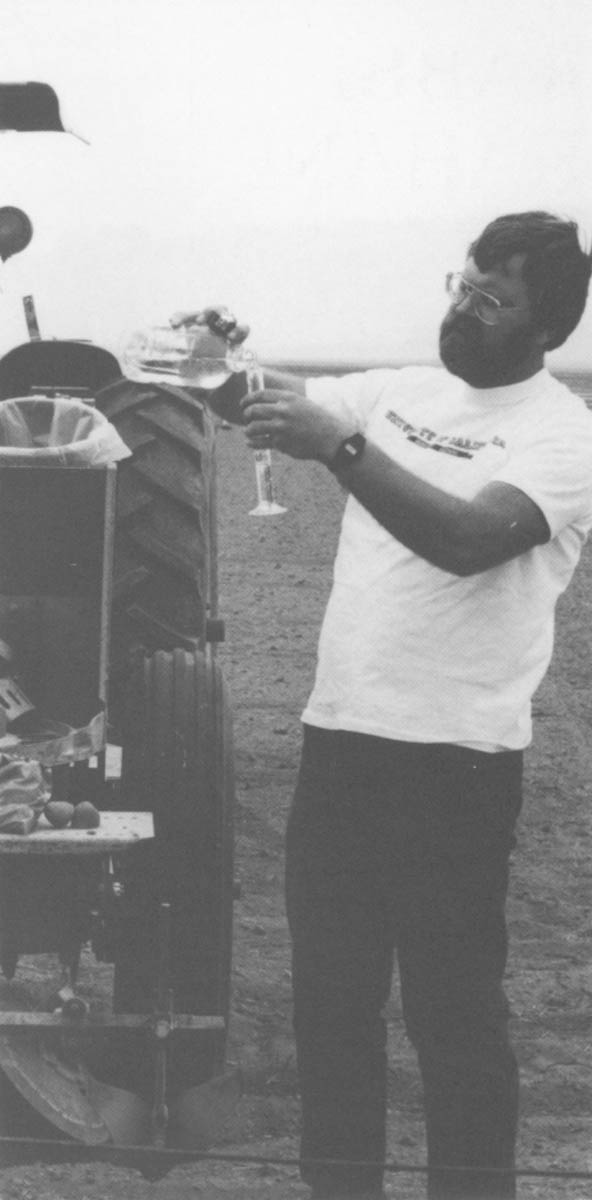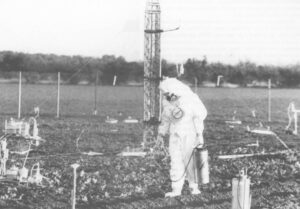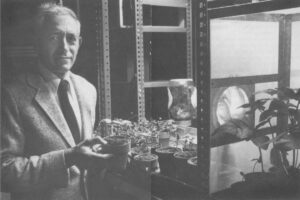In the early morning darkness last April 24, guided by the light from a row of car headlights, a dozen people swarmed over a strawberry patch the size of two tennis courts, setting out hundreds of plastic Petri dishes and mounting equipment on steel towers.
Five times as many of us, reporters and television crews from as far afield as Tokyo, massed outside a chain link fence, shivering in the predawn chill.
As dawn broke a single protester representing Earth First! arrived from San Francisco, 50 miles to the west. Surrounded by cameras, he lauded vandals who had uprooted strawberries in the tiny plot only hours before and proclaimed that a hazardous travesty was about to occur.
In a parody of his dire but long-familiar predictions, a public relations firm hired by Advanced Genetic Sciences (AGS) passed out buttons to the media: “I Survived Frostban, Brentwood, CA 1987.”
Back inside the fence, with dozens of cameras now focused on her, AGS scientist Julie Lindemann donned a white plastic “moonsuit” and respirator–a bit of admitted over-drama required for good measure by the California Department of Food and Agriculture–and posed, garden sprayer in hand.

An Environmental Protection Agency (EPA) monitoring crew signaled its readiness, started up 60-odd vacuum pumps to suck in air samples around the field and a long-delayed stage in the development of biotechnology got underway.
Lindemann moved back and forth across the little plot, spraying the strawberry plants with Frostban, a trade name for two strains of bacteria genetically engineered to retard frost damage.
It has been 14 years since molecular biologists first spliced genetic material, DNA, from one microbe into another to create a recombinant bacteria. Since then scientists working on recombinant DNA or gene splicing experiments have been bound by safety regulations designed to insure that creatures assembled in the labs never escaped.
The first products derived from this science are already making an impact in medicine–human insulin, interferon, growth hormones, vaccines and new anticancer agents. Recombinant bugs chum out these products in the confines of laboratory flasks and industrial fermentation vats.
For many potential applications of biotechnology, however, the recombinant organism is the product: Insect-killing microbes destined to replace chemical pesticides; bugs designed to break down pollutants, convert waste to food and fuels or help recover oil and minerals from the earth; plants altered to tolerate herbicides, insects, diseases, drought, salt or cold; and hardier livestock engineered to grow quickly on less feed. All these creatures must eventually be tested and released outside the lab.
AGS first applied for a permit to test Frostban in an open field in 1983. But season after season the spraying was delayed by repeated court challenges by biotechnology opponent Jeremy Rifkin and fringe environmental groups, disarray among federal agencies that hadn’t yet decided how to regulate such releases, opposition from people who lived near proposed test sites and controversy caused by AGS’s own premature inoculation of trees with recombinant bugs on a rooftop patio at its Oakland headquarters.
The sideshow atmosphere that April morning on the outskirts of Brentwood was a ritual replay of those years of struggle. On the previous day, a Superior Court judge in Sacramento had refused to halt the test again, ruling that there was “no credible evidence” it could cause any harm. That morning was to be the first authorized release of a genetically engineered microbe into the environment.
Within half an hour the spraying was completed.
Five days later, like migrant laborers following the crops, dozens of reporters assembled again near Tulelake, California, to watch a second approved release. This time it was the planting of potatoes coated with a similar bacteria called ice-minus in a field just south of the Oregon border. That test, by Steve Lindow, a University of California, Berkeley plant pathologist, had taken five years to launch.

The media events were short-lived. But the research that will settle all the years of speculation about the risks and benefits of gene splicing was just beginning.
In Brentwood, AGS staffers in blue “Frostbusters” T-shirts–bearing a snowman ringed by the international “no” symbol–fanned out to cover and retrieve petri dishes and pick leaf samples. Technicians from the California Department of Food and Agriculture duplicated their efforts while the EPA crew shut down its pumps and gathered up samples.
Back in their respective labs, with these and other samples taken over the next six weeks, they would get some of the answers that could eventually turn Frostban from a concept into a product: How far would the sprayed bugs drift? How long would they survive? How well would they compete with the native bacteria? Would they do their intended job? Would they cause any problems?
The data also will help determine how elaborate the safeguards and sampling will be for future releases.
By the time the test ended, no problems had materialized, and Frostban-coated plants taken back to the lab survived temperatures several degrees colder than non-treated plants. AGS research director John Bedbrook announced that if follow-up field trails on strawberries and fruit and nut trees over the next few years are successful, the company hopes to gain approval to sell the product to farmers by 1990.
Dozens of other projects involving recombinant microbes have been waiting on the back burners or creeping along in laboratory and greenhouse testing for years. Even as the Frostban and ice-minus tests began, two other proposals for microbial releases were awaiting EPA approval.
Would these first two releases break the logjam and ease the way for testing and marketing of manmade organisms? Or were Frostban and ice-minus more symbolic milestones than practical ones for the industry?
Even while the microbial tests were stalled, a handful of recombinant crops had been planted without fanfare and a live viral vaccine injected into pigs. But it is mutant microbes that cause the greatest concern among ecologists, activists and federal regulators. And because the techniques of gene splicing are more advanced in bacteria than in plants, these creatures also hold the greatest near-term economic promise for the biotechnology industry.
From the fields of northern California I headed south to the restored baroque ballrooms of the Los Angeles Biltmore where the Industrial Biotechnology Association (IBA) was meeting. During the spring and summer I interviewed several dozen executives and scientists from both industry and universities. During that time I encountered both cautious optimism and outright pessimism.
Consultant Peter W. Huber of Science Concepts, assuming the voice of an industry critic, cautioned colleagues not to “feel smug” because of these first two releases: “The most important thing I have going for me in the long run is the gap between the actuality of risk and the public perception…There is no law that says that nice, safe technologies finish first in the regulatory and legal processes.”
Winston Brill, vice president for research and development at Agracetus, also saw little to celebrate. Brill says his own calls to corporate research directors around the country show “there are certainly more than a handful of companies that have stopped doing research in this area. There’s no way one could sell a recombinant microorganism in the next two years. Companies have got to start making money short term. That’s why Agracetus has stayed away from microbes.”
At Brill’s urging the IBA did a quick survey of its own to see if biotech companies are abandoning work on live organisms or taking their test overseas as the makers of two animal vaccines containing live recombinant viruses have done. The responses were few and inconclusive, reflecting apparently the proprietary nature of the projects and a desire to present an optimistic picture for investors.
Optimism is also the message conveyed by IBA technical affairs director Alan Goldhammer. He believes “the regulatory hurdles that are up there right now are going to be relatively brief.” The Frostban and ice-minus releases were good signs, he says, but the really significant milestone will come when the first microbe carrying a foreign gene is allowed outdoors.
Frostban and ice-minus were both created by deleting natural genes, not adding new ones. Lindow and others discovered in the 1970s that certain strains of Pseudomonas living on plant leaves promote frost damage by producing proteins that serve as nuclei around which ice crystals form. Using genetic engineering techniques, they removed the gene that directed production of that ice-nucleating protein. The hope is that ice-minus bacteria, sprayed onto young plants, will crowd out the ice-nucleating strains and give their hosts a few extra degrees of frost tolerance. Despite the struggle over their release, frost-retarding bacteria are almost universally considered harmless.
(Ironically, while the manmade strains have been enduring strict scrutiny, AGS has been marketing the natural ice-nucleating bacteria to ski resorts under the trade name Snomax to increase the effectiveness of their snow-making machinery.)
The first company to apply for a permit to field test a microbe outfitted with foreign genes was Monsanto. Their researchers had inserted a gene for a toxin lethal to caterpillars into a strain of Pseudomonas. The transplanted gene came from a natural microbial pesticide, Bacillus thuringiensis or Bt, that suburban gardeners have been using on their broccoli for two decades. But the EPA requested more greenhouse testing, and the company decided this summer to put the project on hold.
Monsanto has already taken a new tack, however, returning to the EPA with another Pseudomonas, this time engineered to serve as a tracking system rather than carry a toxin. The system is designed to satisfy critics worried about our ability to monitor the fate and impact of recombinant microbes in the environment. The souped-up bug, when subjected to an identity check in a petri dish, will reveal itself by turning turquoise blue, fluorescing and surviving exposure to a specific antibiotic.
If the marker system proves successful in its South Carolina field trial, it may open the way to tests of agriculturally useful spin-offs. Already Monsanto scientists and nearly two dozen other investigators around the world who have signed agreements with the company are busy adding Bt toxin genes and other traits to the recombinant microbe.
As Brill suggested, many agricultural biotech companies have been openly avoiding microbes, or focusing on every technique except gene splicing until the regulatory issues settle out. For instance, chemicals and radiation have been used for decades to mutate microbes. These methods are cruder and less predictable than gene splicing, but largely unregulated. Both Lindow and AGS field tested frost-retarding bacteria created by such methods while their recombinants were snarled in the courts.
Others have come up with novel twists to avoid regulatory delays. Mycogen has actually been field testing a genetically engineered microbe carrying a Bt toxin gene for two years now. But unlike Monsanto’s microbe, Mycogen’s is killed before it is sprayed outdoors. The cell wall of the dead bug simply serves as a capsule to keep the toxin from degrading as quickly as the naked toxin would.
“This was a deliberate decision made because of the regulatory climate,” Mycogen president Jerry Caulder told me. “We came up with a technical solution to what is basically a social problem.”
But Caulder also has positioned his company to begin field testing live products as soon as the regulatory tangles are ironed out. “I’m ready to go to the field with all the products that I’m using in my dead cells,” he said. “I Can just not kill them and I can do field work tomorrow.”
Other companies that have been field testing non-recombinant microbes but keeping genetically engineered strains on the back burner also seem ready to run the regulatory gauntlet soon. A steady stream of applications for environmental release is expected from them in the coming year.
Ecogen, which has been creating and testing new but non-recombinant Bt strains, plans to go to the field as early as next year with genetically engineered Bt varieties that are more potent or toxic to a new range of insects.
Crop Genetics International is hoping to plant corn seed carrying its Bt toxin-producing microbe next March. The bacteria can survive only inside the vascular (circulatory) system of plants, a trait the company hopes will help it win permits for field testing in both the United States and France.
Even before Frostban was released, Biotechnica was waiting in the wings with a request to test a recombinant strain of Rhizobium, a nitrogen-fixing bacteria that has been used to inoculate the roots of legume crops throughout the twentieth century. The Biotechnica strain carries only enhanced copies of one of its own genes–and the potential for increasing alfalfa yields by 10 to 15 percent. The company wants to test another altered strain on soybeans next year.
The recombinant creatures likely to emerge from research labs in the next few years are limited not only by federal regulation and the concerns of ecologists and activists, but by the technology itself. Useful genes must be identified and isolated to be available for transplant. And scientists must have methods for getting these genes into microbes or plant cells, a process called transformation.
Research on viruses and bacteria is most advanced because genetic engineering techniques were developed using these organisms. Enzymes that cut and splice DNA and other chemical tools used routinely by molecular biologists were originally obtained from microbes. Also, once these single-celled bugs are transformed, the work is done. Scientists are not now faced with trying to grow the altered cell into a complex plant or animal and see to it that the new genes work in the proper tissues or organs.
Although genetically engineered plants have fewer regulatory and public image problems to overcome than microbes, the technical hurdles are greater. First, efficient methods are not available for getting new genes into wheat, rice, corn and other economically important cereal grains.
Virtually all of the early field trials with genetically engineered plants have involved tobacco and tomatoes, both of which belong to a class of plants that has proven much easier to transform. But these are more important as model systems than commercial products.
The second problem is the lack of known plant genes specifying useful traits. Among the first field tested plants, one carried a bacterial gene for Bt toxin and two others carried viral genes to confer disease resistance. The only plant genes in early recombinants have been those conferring herbicide resistance.
“Crops, each resistant to a particular company’s herbicide, will flood the market first because we can do that today,” predicts Nicholas M. Frey, director of biotechnology research at Pioneer Hi-Bred International. “But what enzyme, if you changed it, would improve corn production? Or change the quality of a plant fiber? We don’t know enough biochemistry yet to know what enhances yield or growth or stress and disease resistance.”
No genes for startling new traits are available for transforming microbes either. Most researchers now working on new microbes for the farm, factory, mine or toxic waste dump are simply trying to enhance the effectiveness of microbes already in use.
More than 1,000 microbial toxins against insects and weeds are already known, for instance. Sixteen bacterial pesticides, including several brands of Bt, have been marketed since the 1960s. But in their natural forms they have been too short-lived, slow to kill, and narrow in their effects to fulfill the Rachael Carson-era dream of replacing chemical insecticides.
Naturally occurring microbes are already used in toxic waste cleanup, leaching of copper ores and enhanced oil recovery. Significant research is being put into modifying these organisms, much of it in government labs.
But until public perceptions change, “no company in its right mind would even attempt to go into the field” with a genetically engineered organism designed to eat toxic materials, according to Al W. Bourquinn, research director with Ecova, a Seattle company specializing in hazardous waste cleanup. Bourquinn until recently was chief of the EPA’s environmental biotechnology lab at Gulfbreeze, Florida, where work on such organisms for toxic cleanup is concentrated.
No one knows what the real payoffs of genetically engineered organisms will be until the speculations have been tested in real world conditions. But with all the uncertainties clouding releases into the environment, even the most optimistic industry watchers don’t expect to see significant sales of recombinant plants or microbes before the 1990s. It seems certain, however, that those first products, whenever they appear, will not be radically different from the plants and bugs available to farmers today.
©1987 Yvonne Baskin
Yvonne Baskin, a free-lance science writer, is reporting on the release of genetically engineered organisms into the environment.




